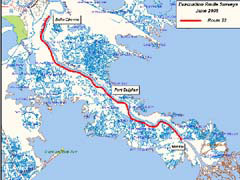The Elements of Geodesy: The
Vertical Datum |
 |
 |
 |
 |
|
|
The position of this vertical survey marker in Louisiana has been upset due to significant subsidence (sinking) of the surrounding area. Click on the image for
a larger view.
|
 |
|
The vertical datum is a collection of specific points on te Earth with known heights either above or below mean sea level. Near coastal areas, mean sea level is determined with a tide gauge. In areas far away from the shore, mean sea level is determined by the shape of the geoid.
Similar to the survey markers used to identify known
positions in the horizontal datum, round brass plates
mark positions in the vertical datum. The traditional
method for setting these vertical benchmarks is called
differential leveling. This method uses a known elevation
at one location to determine the elevation at another
location. As with horizontal datums, the advanced
technology of GPS has almost completely replaced this classical
technique of vertical measurement.
In 1929, the National Geodetic Survey (NGS) compiled all of the existing vertical benchmarks and created the National Geodetic Vertical Datum of 1929 (NGVD 29). Since then, movements of the Earth's crust have changed the elevations of many benchmarks. In 1988, NGVD 29 was adjusted to remove inaccuracies and to correct distortions. The new datum, called the North American Vertical Datum of 1988 (NAVD 88), is the most commonly used vertical datum in the United States today.
 |
|
|
Highway 23 is the main hurricane evacuation route for the entire state of Louisiana. Vertical benchmarks used together with the Global Position System have been critical in tracking rates of subsidence in the area and allowing officials to develop emergency evacuation plans. Click
on the image for a larger
view. |
 |
|
One of the main uses of
the vertical datum is to measure rates of subsidence,
or land sinking. In Louisiana, for example, large
areas of land are rapidly sinking. This is the
result of development, coastal erosion, and high
population levels. In many areas, the only way
to escape an incoming hurricane is to follow specific
hurricane evacuation routes. If state and local
officials do not have accurate elevation information
about these routes, residents trying to leave during
an emergency might get trapped in fast-rising water.
By referencing
the vertical datum, officials can determine the
true elevation and position of the hurricane evacuation
routes, as well as how much they have sunk over
past decades. For example, in Plaquemines
Parish, Louisiana, the main hurricane evacuation
route, Highway 23, and the surrounding levees are
subsiding by one-quarter to one-half inch per
year.
(top)


